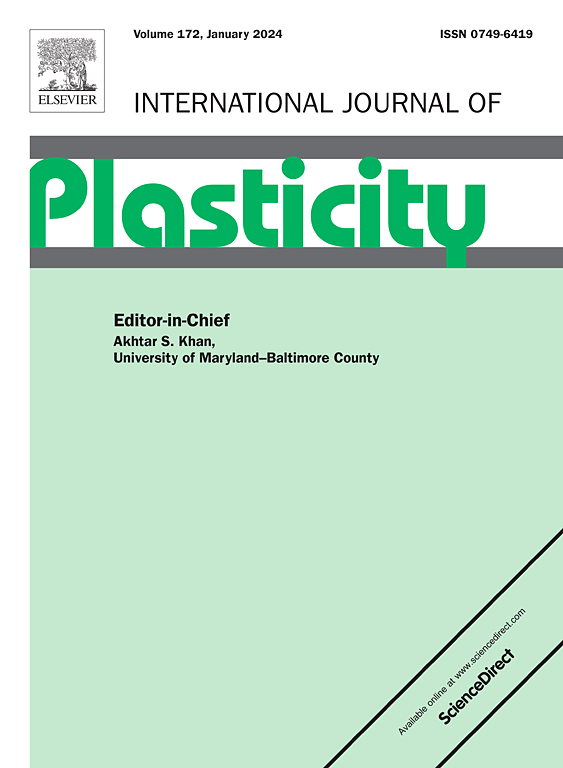考虑微观结构随机性的蠕变破坏双尺度随机分析框架
IF 12.8
1区 材料科学
Q1 ENGINEERING, MECHANICAL
引用次数: 0
摘要
高温蠕变破坏是一个复杂的多尺度、多机制问题,涉及微观结构的随机性。为了研究微观组织对单轴/多轴蠕变破坏的影响,建立了双尺度随机分析框架,将晶界特征引入宏观分析。本文研究了镍基高温合金Inconel 617在长时间蠕变作用下以GB变质为主的蠕变破坏。首先,基于晶体塑性有限元(CPFE)方法和内聚区模型(CZM)研究了GBs的损伤机理。随后,基于得到的GB损伤演化,提出了一种基于GB取向和面积分布统计特征的蒙特卡罗方法来量化宏观蠕变行为的随机性。最后,考虑随机GB方向和面积分布的影响,建立了双尺度随机多轴蠕变损伤模型。数值应用所建立的蠕变损伤模型,捕捉并分析了单轴拉伸试件和受压管中蠕变裂纹的随机萌生和扩展过程。所提出的随机框架有效地考虑了GB特征带来的固有随机性,有效地实现了全场多尺度计算。该方法在高温下蠕变构件和结构的安全评价和寿命预测方面具有潜在的应用前景。本文章由计算机程序翻译,如有差异,请以英文原文为准。


A dual-scale stochastic analysis framework for creep failure considering microstructural randomness
Creep failure under high temperatures is a complex multiscale and multi-mechanism issue involving inherent microstructural randomness. To investigate the effect of microstructures on the uniaxial/multiaxial creep failure, a dual-scale stochastic analysis framework is established to introduce the grain boundary (GB) characteristics into the macroscopic analysis. The GB degeneration-dominated creep failure of nickel-base superalloy Inconel 617 under long-term creep is considered in this study. Firstly, the damage mechanisms of GBs are investigated based on the crystal plasticity finite element (CPFE) method and cohesive zone model (CZM). Subsequently, based on the obtained GB damage evolution, a novel Monte Carlo (MC) approach is proposed to quantify the randomness of macroscopic creep behavior based on the statistical feature of GB orientation and area distribution. Finally, a dual-scale stochastic multiaxial creep damage model is established to incorporate the influence of the random GB orientation and area distribution. With the numerical application of the proposed creep damage model, the random initiation and growth of creep cracks in the uniaxial tensile specimen and the pressurized tube are captured and analyzed. The proposed stochastic framework effectively considers the inherent randomness introduced by GB characteristics and efficiently realizes full-field multiscale calculations. It also shows its potential applications in safety evaluation and life prediction of creep components and structures under high temperatures.
求助全文
通过发布文献求助,成功后即可免费获取论文全文。
去求助
来源期刊

International Journal of Plasticity
工程技术-材料科学:综合
CiteScore
15.30
自引率
26.50%
发文量
256
审稿时长
46 days
期刊介绍:
International Journal of Plasticity aims to present original research encompassing all facets of plastic deformation, damage, and fracture behavior in both isotropic and anisotropic solids. This includes exploring the thermodynamics of plasticity and fracture, continuum theory, and macroscopic as well as microscopic phenomena.
Topics of interest span the plastic behavior of single crystals and polycrystalline metals, ceramics, rocks, soils, composites, nanocrystalline and microelectronics materials, shape memory alloys, ferroelectric ceramics, thin films, and polymers. Additionally, the journal covers plasticity aspects of failure and fracture mechanics. Contributions involving significant experimental, numerical, or theoretical advancements that enhance the understanding of the plastic behavior of solids are particularly valued. Papers addressing the modeling of finite nonlinear elastic deformation, bearing similarities to the modeling of plastic deformation, are also welcomed.
 求助内容:
求助内容: 应助结果提醒方式:
应助结果提醒方式:


